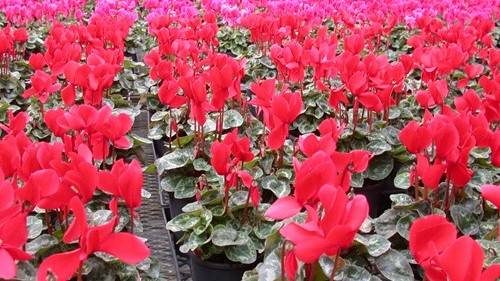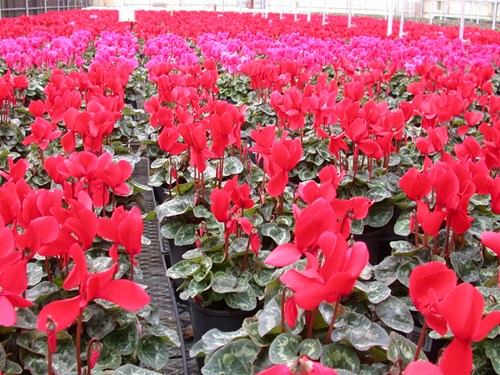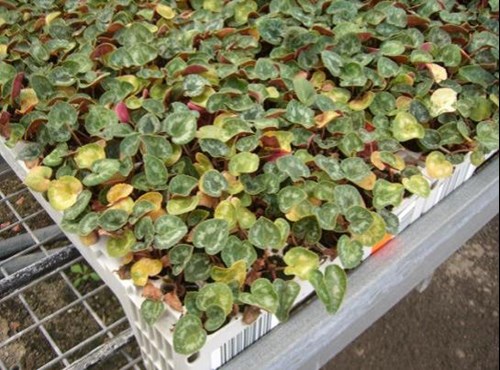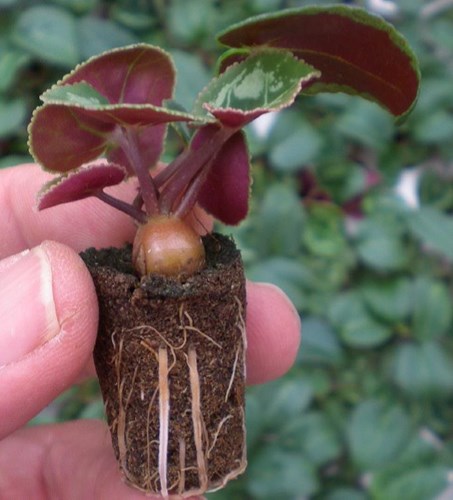Tips For Growing Cyclamen


To successfully produce a cyclamen crop, it is all about good planning before receiving young plants. Cyclamen have a long crop cycle and, therefore, there is more time for problems to occur. Sanitation and good pest monitoring are keys to success.

Sanitize before plants arrive
Cyclamen have a long crop cycle, so the probability of contamination is higher. Cleaning and sanitizing potting areas, tools, machinery, benches, floors and walls is strongly recommended before the crop arrives, so no indigenous disease or pests can infest the young plants when they arrive. Good sanitation should be maintained throughout the crop, to minimize disease problems.
Growing medium
It is important to use a growing medium with high air porosity when producing cyclamen. Premier Tech offers two good growing media with high air porosity, PRO-MIX® HP® AGTIV® AMPLIFY™ and PRO-MIX® HPCC AGTIV® AMPLIFY™.
The difference is that PRO-MIX® HP® AGTIV® AMPLIFY™ dries out more rapidly as PRO-MIX® HPCC AGTIV® AMPLIFY™ has chunk coir, which helps increase water retention.
Mycorrhizae, which is found in both products, is a natural fungus that colonizes root tips and helps acquire water and nutrients for cyclamen.
Bacillus is a natural bacterium that has biostimulant properties for healthier plants.
Both active ingredients stay with the crop throughout the entire production cycle.
Arrival and planting
When young plants arrive, always store them in an isolated area in order to prevent any cross contamination from areas that have not been disinfected yet. Place them in an area that has good light, but is not too intense (200 W/m2) and water lightly if needed, with no fertilizer or acidified water.
Avoid storing plants too long in their trays as this causes stretching and lower leaf loss. If plants are stretched, they will be under more stress and become more fragile, which will delay the crop. It is important to proceed rapidly and transplant into the bigger pots.

Young cyclamen roots are very fragile and can be seriously damaged when transplanting. In order to prevent root damage, dibble a hole in the growing medium before planting, which corresponds to the size of the plug. Use of a gauge will be helpful in standardizing the size and depth of the dibble hole in the pot. Furthermore, when removing the plugs from the trays, it is important to minimize handling in order to avoid root damage.
The bulb in the plug must be placed at the right height when transplanting into a new pot, in order to prevent any cultural problems. It must not be too deep, which can lead to rotting or delays in flowering and not too shallow, as this will cause drying issues. As a rule of thumb, 2/3 of the bulb should be below the growing medium surface and 1/3 above the growing medium. Keep in mind that growing media will shrink during the crop cycle, so consider this when placing the cyclamen bulb.

First leaves (cotyledon)
This first leaf that was formed on the cyclamen is called the cotyledon. After a few months, new leaves will have formed on the cyclamen plant and the cotyledon is no longer needed. Often the cotyledon will dry out and eventually disappear. It is not recommended to remove this leaf, because it can cause a lesion to form on the plant and serve as an entry point for foliar disease.
Watering
Cyclamen are sensitive to overwatering and root rot. If the crop is watered with drippers, be careful not to put the pots directly on the floor, especially if the drainage on the floor is erratic or there are water puddles on the floor. Water can accumulate below the pots, wick back up through the drainage holes into the growing medium and generate irregularities in crop performance. Cyclamen that are kept too wet often get root disease that kills the plant.
Growing on the floor is also a problem, if it is cold, because it slows plant growth and the dry down rate of the growing medium. There is also limited air flow around the plant canopy, unlike growing on a bench where air can circulate from under the crop. All this increases potential for root and foliar diseases.
Sub irrigation may be a better way to water and can reduce labor costs, but the growing medium has to be able to uniformly wick the water from one pot to the next. PRO-MIX® HP® AGTIV® AMPLIFY™ works well with sub irrigation systems, in that it quickly and uniformly wicks up water. How much or how often water is applied has to be adjusted based on the weather, day length and the crops changing needs. Ideally excess water has to drain from the growing medium right after irrigation and must be allowed to dry out sufficiently between waterings to allow for good air porosity in the media. It is best to water frequently and with less water.
As stated, roots are sensitive to asphyxia in the growing media, so whatever method is used to irrigate, keep in mind the following:
- Be sure to check under the pots after watering so that no water is standing beneath the pot.
- When selecting the pots, choose those that have a spacer between the pot and the floor or table that will procure air flow below the pot.
Good drainage is important and it is crucial to check the growing medium to be sure it has sufficiently dried down before initiating irrigation. Spacing pots is also very important to maintain a good air flow in between the plants to minimize foliar diseases.